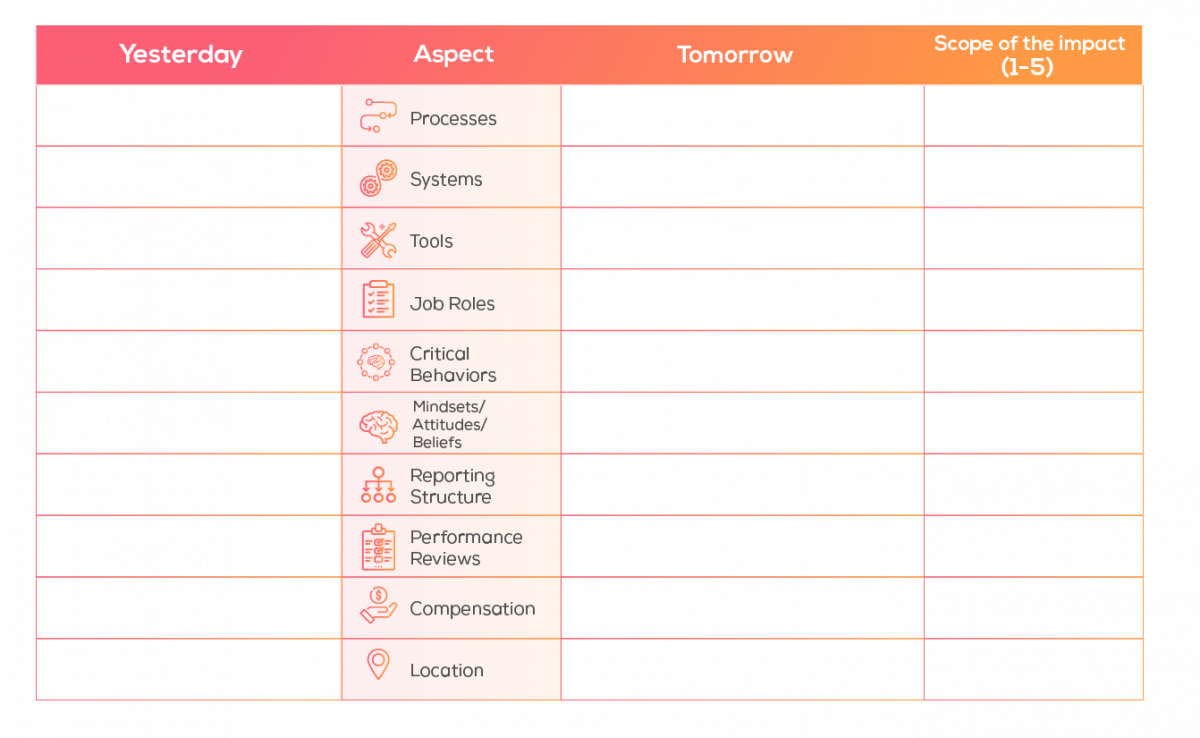Your quick starter Guide to defining Change Impact.
22 November 2022
Discover the 10 aspects you should consider to get more clarity on your change and empower the people.
Article written by Renaud de Lombaert
22 November 2022
Discover the 10 aspects you should consider to get more clarity on your change and empower the people.
Article written by Renaud de Lombaert
If change were easy to define and prepare for, we would know. Organisations would all be thriving; resistance wouldn't be a thing. But this is where it gets hot and blurry: leaders and managers don't always have a clear understanding of the intricacies of their change project and its tangible impacts on people's working routines.
Yet, change starts where it always does: with the people. It finds fertile ground for growth depending on how confident and prepared they feel about moving forward. And it fails or succeeds depending on how many of them adopt and use the solution with proficiency.
Don't leave the change to chance. Bring change impact into focus and empower the people. NEXUM guides you through the exercise, from the definitional challenges to the ten aspects you should consider to kickstart your CM efforts.
What's in a word; what's at stake. Change happens all around us as organisations must face increased uncertainty head-on. Straightforward examples include mergers, appointing new leadership, developing processes that focus on the client experience, or implementing new technology and business models. Organisational change is any action that alters the status quo of an organisation, including but not limited to shifts in "culture, internal processes, technology or infrastructure" [1]. And no matter the depth and breadth of the change, it is unsettling and mostly painful.
The harsh reality is that 70% of change projects fail to deliver on their promises. Furthermore, the more failures an organization racks up, the harder it becomes to manage future changes. All of which can be devastating to business operations and continuity. Now, what separates successful change from unsuccessful attempts?
One person can make a difference. Together, they make the change. Success happens when you can say for sure that a change project is delivering organisational benefits. But a substantial portion of the ROI is people-dependent. The most well-rounded project can only go so far. It's not about what you do, it's about how well it is done. People must adopt the change and use it proficiently in a sustainable way. In other words:
A structured process to support, equip and enable the people, one person at a time[2]. This is where Change Management begins. By individual change, we mean that every single member of the organisation has to go through their personal ADKAR journey: first gaining full self-awareness (Awareness) and commitment to the project (Desire), then being equipped (Knowledge) and able to adjust work routines (Ability) sustainably on their own (Reinforcement).
But to start helping people and designing robust CM plans, you have to understand how change is enacted in the day-to-day life of Peter, Marie, Carlos and Fatima. Articulating the impact of the change at the individual level is possibly the most significant challenge Change Managers must face. Still, being very specific about the change has a huge payoff: if you can name it, you can tame it.
Brainstorming with the ten aspects model can help you surface who/which groups will be most affected and how. The box below lays out each component of the impact assessment.

Let's consider the following example (based on PROSCI) to make things easier to understand. A new cloud-based CRM (Customer Relationship Management) can have a far-reaching and significant impact across the organisation. Say your company wants to get on board with this trend. What would each of the 10 aspects include if the change were put into practice?
Change practitioners know that mapping change impacts is an incredibly powerful tool. Here are at least 8 applications that demonstrate why:

The impact assessment is one of seven different types of assessments that PROSCI suggests you do in order to plan and execute a Change Management strategy. If you are interested in learning more about PROSCI's three-phase process and methodology to get a head start on your change management journey, check out our upcoming certification programs. And feel free to explore our extensive library of resources to brush up on your knowledge of Change Management advancements!
[1] Stobierski T. (2020), What is organisational change management and why it’s important, Harvard Business Review [online] https://online.hbs.edu/blog/post/organizational-change-management